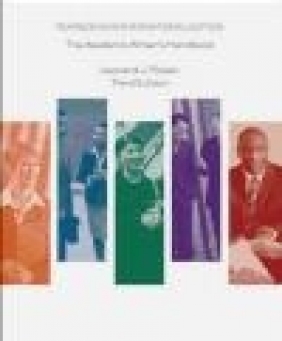Academic Writer's Handbook
Leonard Rosen
Academic Writer's Handbook
Leonard Rosen
- Producent: Pearson
- Rok produkcji: 2013
- ISBN: 9781292026190
- Ilość stron: 624
- Oprawa: Miękka
Niedostępna
Opis: Academic Writer's Handbook - Leonard Rosen
With its unique focus on source-based writing and writing across the curriculum, The Academic Writer's Handbook contains all the features of a traditional handbook combined with the tools students need in order to read, write, and conduct research in the disciplines.Glossary Preface Part 1 Critical Thinking and Reading 2. Understanding Sources a Understanding print sources b Understanding Web sites c Understanding images 3. Critical Thinking and Reading to Evaluate a Evaluating print sources b Evaluating Web sites c Evaluating images 4. Responding to Sources a Setting goals for reading to respond b Applying techniques for reading to respond c Moving personal responses into your papers 5. Summarizing, Paraphrasing, and Quoting a Summarizing and paraphrasing sources b Quoting sources c Altering quotations 6. Weaving Sources into Your Papers a Building evidence-based paragraphs b Making standard "moves" with sources c Weaving quotations into your sentences d Identifying authors in your sentences 7. Synthesizing Sources a Understanding your purpose for synthesizing sources b Creating an index to your sources Part 2 Critical Thinking and Writing 8. Understanding Your Assignment and Audience a Understanding your assignment b The audience for your assigned paper c Generating ideas and information 9. Devising the Thesis a Thesis definitions b Focusing on the claim and your ambitions for the paper 10. Planning the Paper and Building the Draft a Using the working thesis to identify parts of the paper b Preparing a formal outline c Writing a draft collaboratively d Sample student paper: First draft 11. Global Revision and Peer Review a Bringing your main idea into focus b Peer review 12. Section/Paragraph/Sentence Revision a Section-level revision: Developing your main idea b Paragraph-level revision c Sentence-level revision d Sample student paper: Final draft Part 3 Making Arguments in the Disciplines 13. Writing Arguments in the Humanities a Overview of the humanities b Making arguments in the humanities 14. Writing Arguments in the Social Sciences a Overview of the social sciences b Making arguments in the social sciences 15. Writing in the Natural and Applied Sciences a Overview of the sciences b Making arguments in the sciences c Types of writing assignments in the sciences 16. Applying Principles of Academic Writing to Business Settings a Overview of business communication b Writing letters or e-mails of inquiry, complaint, and application c Writing resumes (print and Web-based d Making oral presentations Part 4 Library of Academic Writing 17. Summary a Summary defined b Planning and writing the paper Sample student paper in the Humanities (MLA) 18. Explanation a Explanation defined b Planning and writing the paper Sample student paper in the Social Sciences (APA) 19. Analysis a Analysis defined b Planning and writing the paper Sample student papers: in the Social Sciences (APA) in the Sciences (CSE) 20. Literary Analysis a Literary analysis defined b Planning and writing the paper Sample student paper in the Humanities (MLA) 21. Critique a Critique defined b Planning and writing the paper Sample student papers: in the Humanities (MLA) in the Social Sciences (APA) 22. Argument a Argument defined b Making a claim c Ethos: Establishing yourself as trustworthy d Logos: Supporting your claim with logical reasons e Pathos: Supporting your claim with emotional reasons f Gathering evidence g Avoiding fallacies of evidence and logic h Responding to counterarguments i Writing your argument Sample student paper in the Humanities (MLA) 23. Proposal a Proposal defined b Planning and writing the paper Sample student paper in the Sciences (CSE) 24. Essay exams a Essay exam writing defined b Planning and writing the in-class essay c A note on "Big Ideas" Sample student essay exam in the Sciences (CSE) Part 5 Research 25. The Research Process a Defining the task: Topic, purpose, and audience b Identifying your research question c Generating a plan for research d Devising a working thesis and writing a draft e Record-keeping: Creating a working bibliography 26. Locating Electronic and Print Sources a Reviewing sources for preliminary research and reading b Focusing your research c Locating sources on the Web d Additional Web sites for researchers e Bringing your research to an end 27. Avoiding Plagiarism a Citing sources b Causes of plagiarism c Three rules for avoiding plagiarism d Determining common knowledge e Plagiarism, the Internet, and "Fair Use" f Collaboration and plagiarism Part 6 MLA Documentation 28. Using the MLA System of Documentation Quick Index a In-text citations b Works Cited models Part 7 APA, CMS, CSE Documentation 29. Using the APA System of Documentation Quick Index a In-text citations b References 30. Using the CMS and CSE Systems of Documentation CMS a First and subsequent references in CMS notes b CMS notes style CSE c In-text citations in CSE format d Entries in the CSE References list Part 8 Multimedia Resources 31. Multimedia Presentations a Writing and multimedia: Similarities and differences b Composing Web sites c Composing blogs d Composing wikis e Composing slideshows f Composing audio podcasts g Composing digital video h Designing written documents 32. Digital Sources: Images, Audio, Video a Fair use/Transformative use b Public domain c Copyright friendly d Resources for finding digital media e A reminder Part 9 Revising for Sentence Structure and Clarity 33. Correcting Sentence Fragments a Dependent clauses b Phrases c Compound predicates 34. Correcting Comma Splices and Run-on Sentences a Identifying errors b Correcting errors 35. Building Emphasis with Coordination and Subordination a Coordination with and/but, consequently b Subordination with while, when, because c Mixing coordination and subordination 36. Correcting Errors in Consistency a Shifts in person and number b Shifts in tense, mood, and voice c Direct and indirect speech d Logic among sentence parts e Consistent relations f Constructions with missing words g Clear comparisons 37. Being Clear, Concise, and Direct a Wordiness b Strong verbs 38. Precision: Choosing the Right Word a Dictionary entries b Vocabulary building c The impact of words d Tone e Biased language Part 10 Revising for Correctness 39. Using Verbs a Principal parts b Irregular verbs c Auxiliary verbs d Transitive and intransitive verbs e Tense f Tense sequencing g Active and passive voices h Mood 40. Correcting Errors in Subject-Verb Agreement a Subject number and verb agreement b Indefinite (in number) and other subjects 41. Correcting Errors in Pronoun-Antecedent Agreement & Reference a Pronoun-antecedent and number b Clear pronoun reference 42. Correcting Misplaced and Dangling Modifiers a Positioning modifiers b Limiting modifiers c Squinting modifiers d Disruptive modifiers e Dangling modifiers 43. Using Adjectives and Adverbs a Adjectives and adverbs b Adjectives and linking verbs c Using comparatives and superlatives d Logic of comparatives and superlatives e Double comparisons, superlatives, and negatives f Past and present participles as adjectives 44. Using Nouns and Pronouns a Pronouns as subjects b Pronouns as objects c Nouns/pronouns to show possession d Pronouns in compound constructions e Pronouns paired with nouns f Choosing who/whom g Pronouns in comparisons 45. Correcting Faulty Parallelism a Parallelism with and, but, for, or, nor, so, yet b Parallelism with either/or, neither/nor, both/and, not only/but also c Parallelism in sentences with compared and contrasted elements Part 11 Revising Punctuation, Mechanics, and Spelling 46. Using End Punctuation a The period b The question mark c The exclamation point 47. Using Commas a Commas with introductory and concluding expressions b Commas before coordinating conjunctions c Commas between items in a series d Commas to set off nonessential elements e Conventions of quoting, naming, and various forms of separation f Misuse or overuse of commas 48. Using Semicolons a Linking independent clauses b Linking independent clauses with a conjunctive adverb (however, therefore) c Linking independent clauses with a coordinating conjunction (and, but) d Separating items in a series e Quotation marks and semicolons 49. Using Apostrophes a Possession with nouns and pronouns b Contractions marking the omission of letters and numbers c Plural forms of letters, numbers, and symbols 50. Using Quotations Marks a Direct quotations b Dialogue and other material c Misuse or overuse of quotation marks 51. Using Other Marks a The colon b Dashes for emphasis c Parentheses to set off nonessential information d Brackets for editorial clarification e Ellipses to indicate a break in continuity f The slash 52. Using Capitals a The first letter of the first word in every sentence b Words of significance in a title c The first word in every line of poetry, according to conventions d Proper nouns 53. Using Italics a Words for specific emphasis b Words, letters, and numbers to be defined or identified c Titles of book-length works d The Internet 54. Using Abbreviations a Titles of rank both before and after proper names b Specific dates and numbers c Acronyms, uppercase abbreviations, and corporate abbreviations d Latin expressions e Misuse of abbreviations 55. Using Numbers in Writing a Numbers that begin sentences and one-or two-word numbers b Conventional use of numbers 56. Using Hyphens a Compound words b Word divisions at the end of a line 57. Making Spelling Decisions a Homonyms and commonly confused words b Basic rules for ie/ei c Rules for using prefixes d Rules for using suffixes e Rules for forming plurals Part 12 Multilingual Users' Guide 58. The Fundamentals of Grammar a Five patterns b Sentence parts c Phrases d Clauses e Sentence classification 59. Using English Nouns, Pronouns, and Articles a English nouns b Articles with nouns c Nouns with prepositions 60. Using English Verbs a Different types of verbs b Verb forms c Word order d Helping verbs e Gerunds and infinitives f Two- and three-word verbs with participles 61. Using Modifiers and Connectors in English Sentences a Single-word adjectives and nouns b Adjectival modifiers with linking verbs and prepositions c Adverbial modifiers d Phrases and clauses to modify nouns and pronouns e Clauses and phrases with connecting words f Cumulative modifiers
Producent:
GPSR Pearson Central Europe Sp. z o.o.
ul. Szamocka 8
01-748 Warszawa (PL)
tel: 459 596 060
email: [email protected]
Szczegóły: Academic Writer's Handbook - Leonard Rosen
Tytuł: Academic Writer's Handbook
Autor: Leonard Rosen
Producent: Pearson
ISBN: 9781292026190
Rok produkcji: 2013
Ilość stron: 624
Oprawa: Miękka
Waga: 1.37 kg























